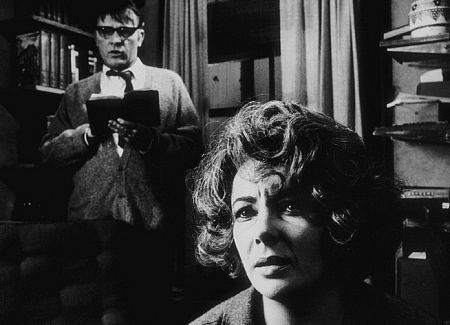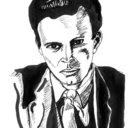Cast: Elizabeth Taylor, Richard Burton, George Segal, Sandy Dennis
There are many things in this world that I find truly baffling. Why are we destroying our marine habitats so that rich Japanese couples can order expensive soup? Why do we demand that politicians solve all our problems for us, while secretly willing them to fail? Why do we keep expecting Guy Ritchie to make another good film? But perhaps the most baffling of all is the fact that Whose Afraid of Virginia Woolf? has never been released on DVD in Britain.
It is perhaps the finest filmic adaptation of a stage play ever rendered on celluloid. But only American audiences are able to enjoy it in the comfort of their own homes. Adaptations of plays can often be morbidly dull. They rely on the same visceral energy and tension that works so well in a theatre but is almost impossible to transfer onto a video recording that will be reproduced thousands of times and watched at the furthest possible remove (both emotionally and geographically) from where the actors actually performed.
The History Boys is ok, but it was a chirpy and simple play in the first place. Lindsey Anderson’s adaptation of David Storey’s play In Celebration was fairly successful at transferring the dramatic silence and tension of a play, but it was still fairly two-dimensional on a cinematic level.
Whose Afraid of Virgina Woolf? leaps over all of these pitfalls. Every time you watch it, it feels urgent and real. You feel like you are sitting in Martha and George’s house and you hope that Elizabeth Taylor won’t forget her lines as she is carried away in a spitting, passionate frenzy of emotion.
The story concerns a bitter, warring couple in the clutches of despair and alcoholism. Martha is the daughter of the College Dean, and her husband George is in the history department (although as Martha constantly reminds him he is not the history department) They live on the grounds of the college and escape from their dull lives by drinking and playing hurtful and heinous psychological ‘games’ with each other.
On this particular night a young couple, new to the college, arrive for a welcome drink. Nick is a fresh-faced, athletic biology professor and Honey is his mousey, chirpy wife. Over the course of the evening we see the relationships between these four people deteriorate. It may not sound very positive – and it isn’t – but it is wickedly funny at times and filled with the kind of conflict and tension that most filmmakers lie in bed dreaming about.
It is, however, a stage play in every regard: the entire story takes place in George and Martha’s house; the dialogue is dense and fast; and the tension relies on the viewer’s proximity to the awkward silences and spitting tirades of the actors. So why did this film succeed where so many theatrical adaptations have failed? I was about to describe it as ‘one of those inexplicable, synergistic moments in cinema’, but then I realised that this film absolutely does add up to the sum of it’s extraordinary and acclaimed creative parts.
To begin with, it was Ernest Lehman who decided to adapt Edward Albee’s successful stage play. This is the same Ernest Lehman who cut his teeth on the screenplays for North by Northwest, The Sound of Music, and The Sweet Smell of Success to name but a few; I think it is safe to say that the screenplay was in safe hands.
But who could possibly helm such a difficult production? Well Lehman and his Warner Brothers financiers finally settled on a young theatre director who, at the tender age of 32, had directed his first Broadway smash hit (Neil Simon’s Barefoot in the Park) which ran for 1530 performances. His name was Mike Nichols, and he would go on to direct a few fairly successful films like The Graduate, Working Girl, Primary Colours, and Charlie Wilson’s War.
Nichols may be a household name now; but in 1966 he was better known as a comedian and director of quirky Neil Simon plays. This comedic sensitivity certainly came in handy in this production, where the dark humour and poisonous wit espoused by the central characters needs a deft touch to prevent it being overlooked or, which is worse, overly obvious.
But this production really needed a serious talent behind the camera to aid the inexperienced Nichols. And who better than Haskell Wexler, the two-time Oscar winning cinematographer behind One Flew over the Cuckoo’s Nest and Bound for Glory. The camerawork in this film is perhaps the most important device for capturing the immediacy and energy of a play, and Wexler’s camera does this very well.
The cinematography is alive and perfectly attuned to the pace, tone, and emotional resonance of the characters and their story. Every time you feel that, had you been sitting in the stalls, you would be staring intently at George’s face – or gazing, overwhelmed, into the space between Nick and Martha – this is exactly what the camera does.
Wexler also worked on one of my favourite films of all time, John Cassavetes’ Faces. Cassavetes was a theatre man himself; and his films always relied heavily on the performances of his actors. Faces is one of his most stripped down films, and it is very theatrical in its unity of time and space (a pretentious was of saying that it happens in a limited number of locations over a limited timeframe). Wexler’s camerawork in that film is equally successful. He is at once obtrusive and subtle, sporadic and consistent, energetic and whimsical. You are never allowed to stop concentrating and yet you so rarely think to yourself “I am viewing this drama through the eyes of a man looking through a lens 44 years ago.”
But what are a director and his cinematographer without a cast to direct and film? This is one area of pre-production that was fraught with difficulty for Lehman and Warner Brothers. Every Hollywood star from Henry Fonda to Bette David wanted to be involved; but the density of the dialogue and the energy required from the starring duo left Nichols and Fonda doubting these weary and ageing Hollywood veterans.
Looking back, I’m sure no one can imagine anybody else playing George and Martha in this film. Richard Burton had had a mixed career, combining Hollywood epics with smaller independent films. But through the early 1960’s he starred in Tony Richardson’s Look Back In Anger (the first film that he was truly proud of) and John Huston’s The Night of the Iguana. I think that Whose Afraid of Virginia Woolf? was the triumphant pièce de résistance of a veritable legend of the cinema; and it came at a time when he had mastered the complexity of film and the raw emotional power of the theatre.
Elizabeth Taylor was considered by many to be the most beautiful woman in the world in the mid-1960s, and she was certainly one of the most powerful stars in Hollywood after her performance in Cleopatra and Cat on a Hot Tin Roof. But her performance in this film is measured, mature, and selfless.
It is now well known that Burton and Taylor’s marriage was on the rocks by the time they started filming, and their relationship finally broke down as a result of this film. Regardless of what was happening in their private lives, there is no doubt that these are two of the finest and most emotionally honest performances ever given in a Hollywood film. Burton is powerful but easily hurt, Taylor is a frumpish bully with a tender and weary heart. They both cackle and spit their way through a truly powerful, and pessimistic, story of a love that has been lost and is sorely missed.
I apologise if this has been more an extended biography of the cast and crew than a review of the film. But I think it is important to appreciate what Hollywood can do when it puts its mind to something. Warner Brothers assembled a perfect group of people: a young and passionate director, an experienced screenwriter and cinematographer, and a pair of well-known but underrated actors. And they created one of the most beautiful and heart-breaking films in cinema history.
Now I just wish they would share it with the rest of the world!






No comments :
Post a Comment